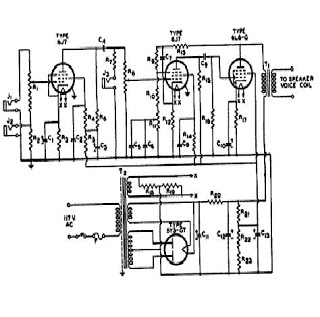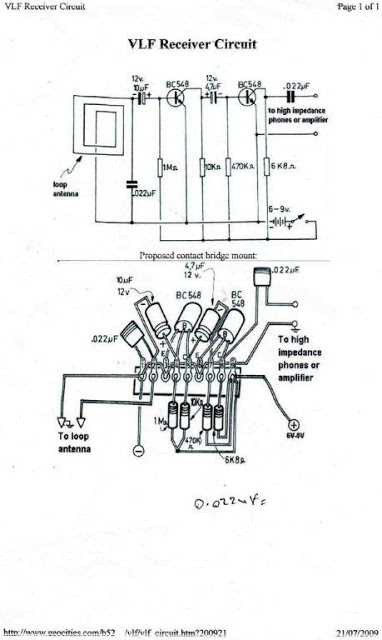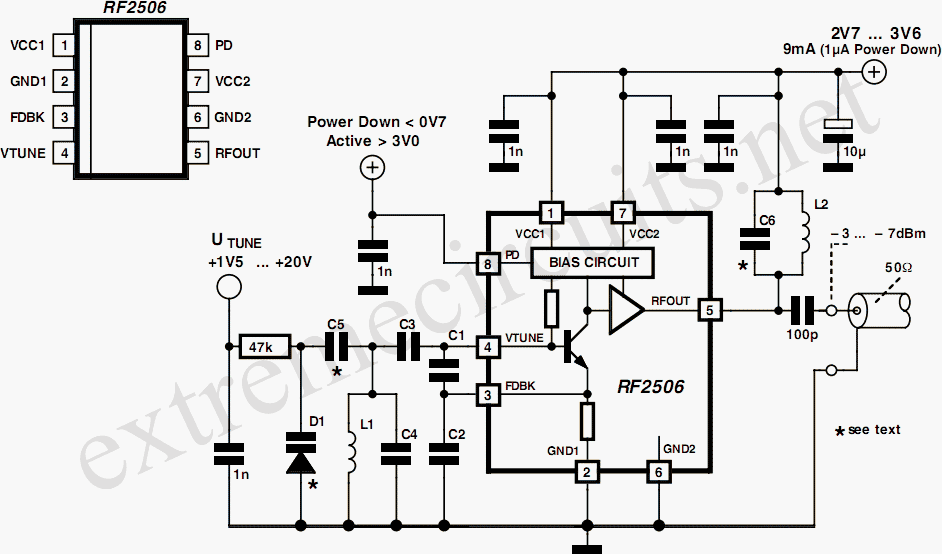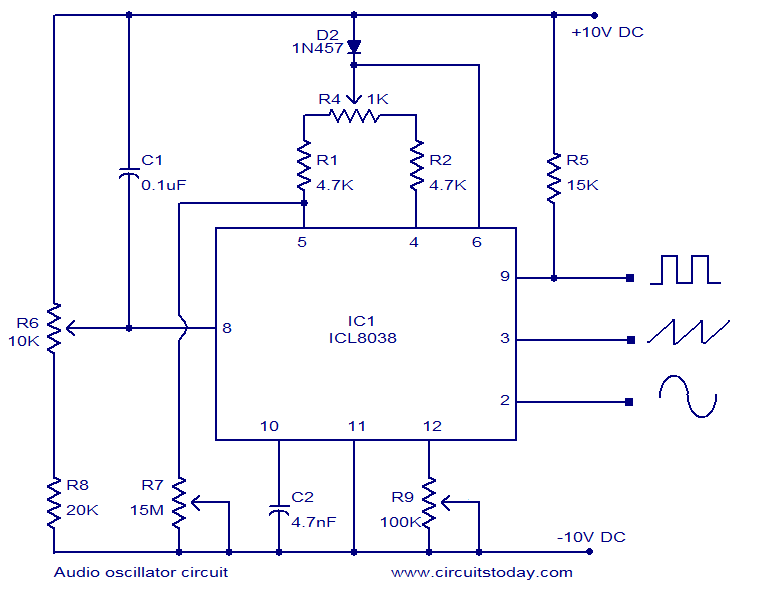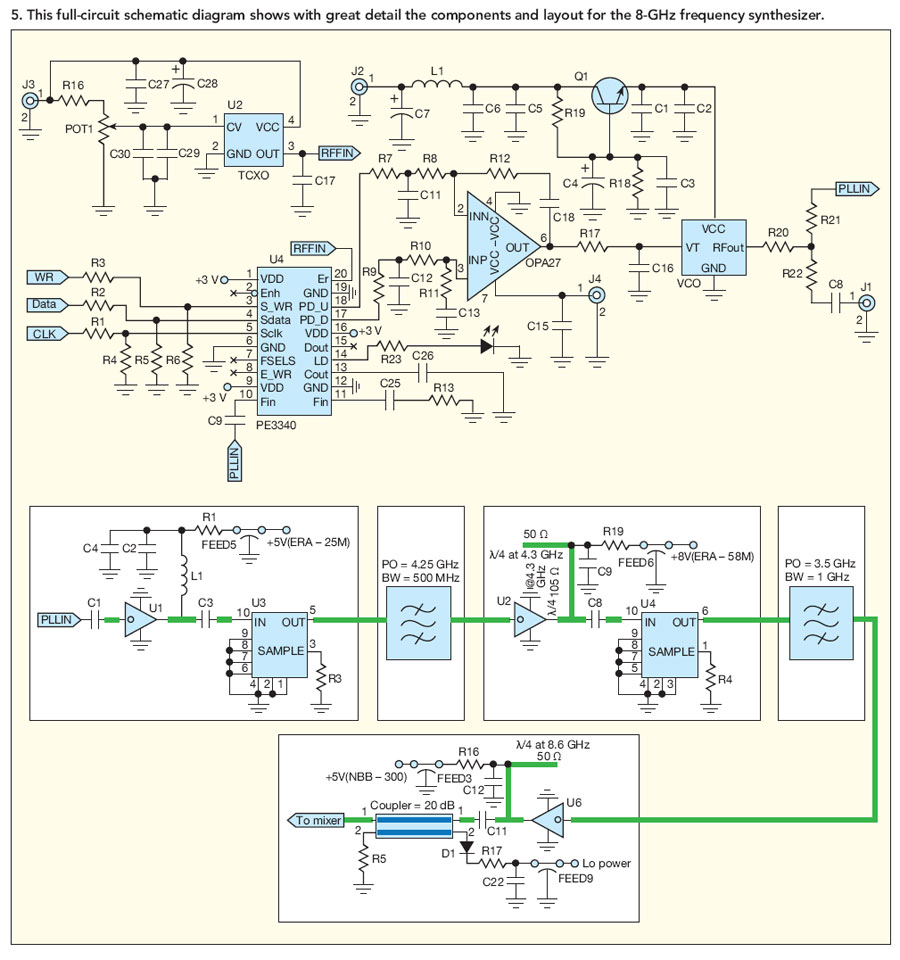
1 KHz Frequency Wien Bridge Oscillator
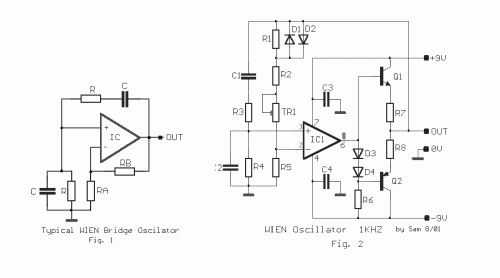
The circuit was designed to create an electronic oscillator known as a Wien Bridge Oscillator, which can be used for the creation of low-frequency sine waves.
The Wien Bridge Oscillator is a type of electronic oscillator that generates sine waves. It is notable for its ability to produce low-frequency signals with high stability and low distortion. The fundamental operation of the Wien Bridge Oscillator is based on a bridge circuit that includes resistors and capacitors, providing a precise frequency determination.
The core of the circuit consists of four resistors and two capacitors arranged in a bridge configuration. The resistors are typically labeled R1, R2, R3, and R4, while the capacitors are labeled C1 and C2. The bridge is balanced when the ratio of the resistances and capacitances satisfies the condition for oscillation. The frequency of oscillation can be calculated using the formula:
\[ f = \frac{1}{2\pi R \sqrt{C1 \cdot C2}} \]
where \( R \) is the resistance value that is typically equal for R1 and R2, and R3 and R4, while C1 and C2 are the capacitances.
To initiate oscillation, a gain element, usually an operational amplifier (op-amp), is employed. The gain of the op-amp is adjusted using a variable resistor (often referred to as a light bulb or thermistor in classic designs) to maintain the oscillation. This automatic gain control is crucial as it stabilizes the amplitude of the output sine wave, preventing distortion and ensuring consistent performance over time.
In practical applications, the Wien Bridge Oscillator is utilized in various fields, including audio signal generation, function generators, and testing equipment. Its simplicity and effectiveness make it a popular choice among engineers and hobbyists for generating sine wave signals in low-frequency applications. Proper layout and component selection are essential to minimize noise and ensure the fidelity of the generated waveform.The circuit was designed to create an electronic oscillator known as Wien Bridge Oscillator which can be used for the creation of low frequency sine wave. 🔗 External reference
The Wien Bridge Oscillator is a type of electronic oscillator that generates sine waves. It is notable for its ability to produce low-frequency signals with high stability and low distortion. The fundamental operation of the Wien Bridge Oscillator is based on a bridge circuit that includes resistors and capacitors, providing a precise frequency determination.
The core of the circuit consists of four resistors and two capacitors arranged in a bridge configuration. The resistors are typically labeled R1, R2, R3, and R4, while the capacitors are labeled C1 and C2. The bridge is balanced when the ratio of the resistances and capacitances satisfies the condition for oscillation. The frequency of oscillation can be calculated using the formula:
\[ f = \frac{1}{2\pi R \sqrt{C1 \cdot C2}} \]
where \( R \) is the resistance value that is typically equal for R1 and R2, and R3 and R4, while C1 and C2 are the capacitances.
To initiate oscillation, a gain element, usually an operational amplifier (op-amp), is employed. The gain of the op-amp is adjusted using a variable resistor (often referred to as a light bulb or thermistor in classic designs) to maintain the oscillation. This automatic gain control is crucial as it stabilizes the amplitude of the output sine wave, preventing distortion and ensuring consistent performance over time.
In practical applications, the Wien Bridge Oscillator is utilized in various fields, including audio signal generation, function generators, and testing equipment. Its simplicity and effectiveness make it a popular choice among engineers and hobbyists for generating sine wave signals in low-frequency applications. Proper layout and component selection are essential to minimize noise and ensure the fidelity of the generated waveform.The circuit was designed to create an electronic oscillator known as Wien Bridge Oscillator which can be used for the creation of low frequency sine wave. 🔗 External reference
